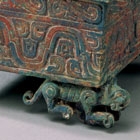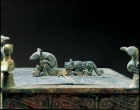J.J. Lally & Co., Oriental Art / New York City, New York
MenuPast Exhibition
Arts of Ancient China
March 27 - April 12, 2006
9.
AN ARCHAIC BRONZE BOX ON WHEELED TIGERS
Zhou Dynasty, 8th Century B.C.
of quadrangular form, raised on the backs of stylized tigers aligned in pairs under the four corners, each tiger cast in the round with its hollow torso concealing a small bronze wheel on a short axle between the forelegs, the flat top of the box projecting over the sides and decorated at the corners with four stylized birds each on a peg loosely held in a short cylindrical base, able to turn freely but not removable, the well-fitted flat cover in the form of a matched pair of doors hinged on integral pins extending into sockets at the corners and cast at the center with a free-standing small tiger on one door, lined up behind a crouching bear on the other door, with a slot between the animals’ legs to receive a squared peg with tiger-head terminal which serves as a locking mechanism, the surface of the doors decorated in shallow flat relief with addorsed pairs of profile dragon heads encircled by scroll motifs, with fine linear detailing, flanked by twin-spiral scroll borders on two sides of the top, the four sides of the box with a matching border of twin-spiral scrolls all around, above the main frieze of undulating scroll bands filled with hooked ‘C’-scrolls and shield-shaped motifs above and below to form a repeating pattern, all in the same flat shallow relief as the decoration on the cover, the base plain, the surface lightly encrusted with an attractive bluish-green patina mottled with reddish cuprite on the sides.
Height 4 1⁄4 inches (10.8 cm)
Length 5 1⁄2 inches (14 cm)
A similar rectangular box on wheels, also with supports in the form of wheeled crouching tigers and with four bird finials, excavated in 1989 at Shangguo village, Wenxi county, Shanxi Province, now in the Shanxi Provincial Institute of Archaeology, Taiyuan, was included in the 1998 special exhibition at the Solomon R. Guggenheim Museum and illustrated in the catalogue entitled China: 5000 years - Innovation and Transformation in the Art, New York, 1998, no. 42. Another smaller rectangular box raised on human figure supports, excavated in 1974 at Shangguo village, Wenxi county, Shanxi Province, now in the Shanxi Provincial Museum, is illustrated in Shanxi Wenwu Guancang Zhenpin: Qingtongqi (Selected Cultural Relics from Local Museums in Shanxi: Bronzes), Shanxi, n.d. p. 50, no. 76.
Compare also the larger bronze box of closely related form supported on four kneeling human figures, excavated in 1993 from tomb no. 63 at the Jin State cemetery site, Beizhao village, Tianma-Qucun site, Shanxi province, now also in the Shanxi Provincial Institute of Archaeology, illustrated in Wenwu, 1994, No. 8, p. 13, fig. 23 and in line drawings on p. 14, fig. 24, no. 2. The same piece is also illustrated in Zhongguo Qingtongqi Quanji (Compendium of Chinese Bronzes), Vol. 6, Western Zhou (2), Beijing, 1997, p. 57, nos. 58-61.
周 青銅臥虎輪盒 高 10.8 厘米 長 14 厘米

